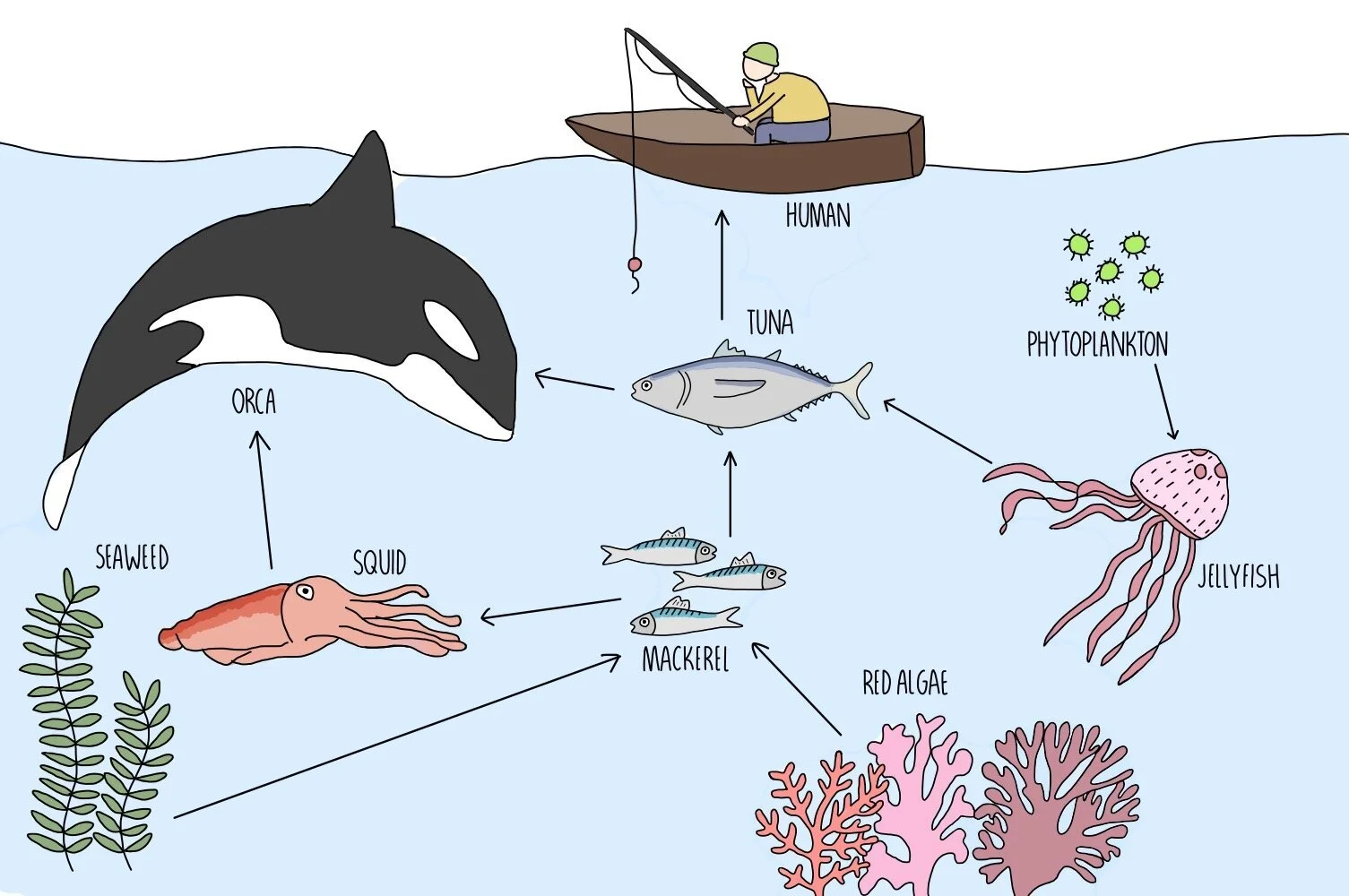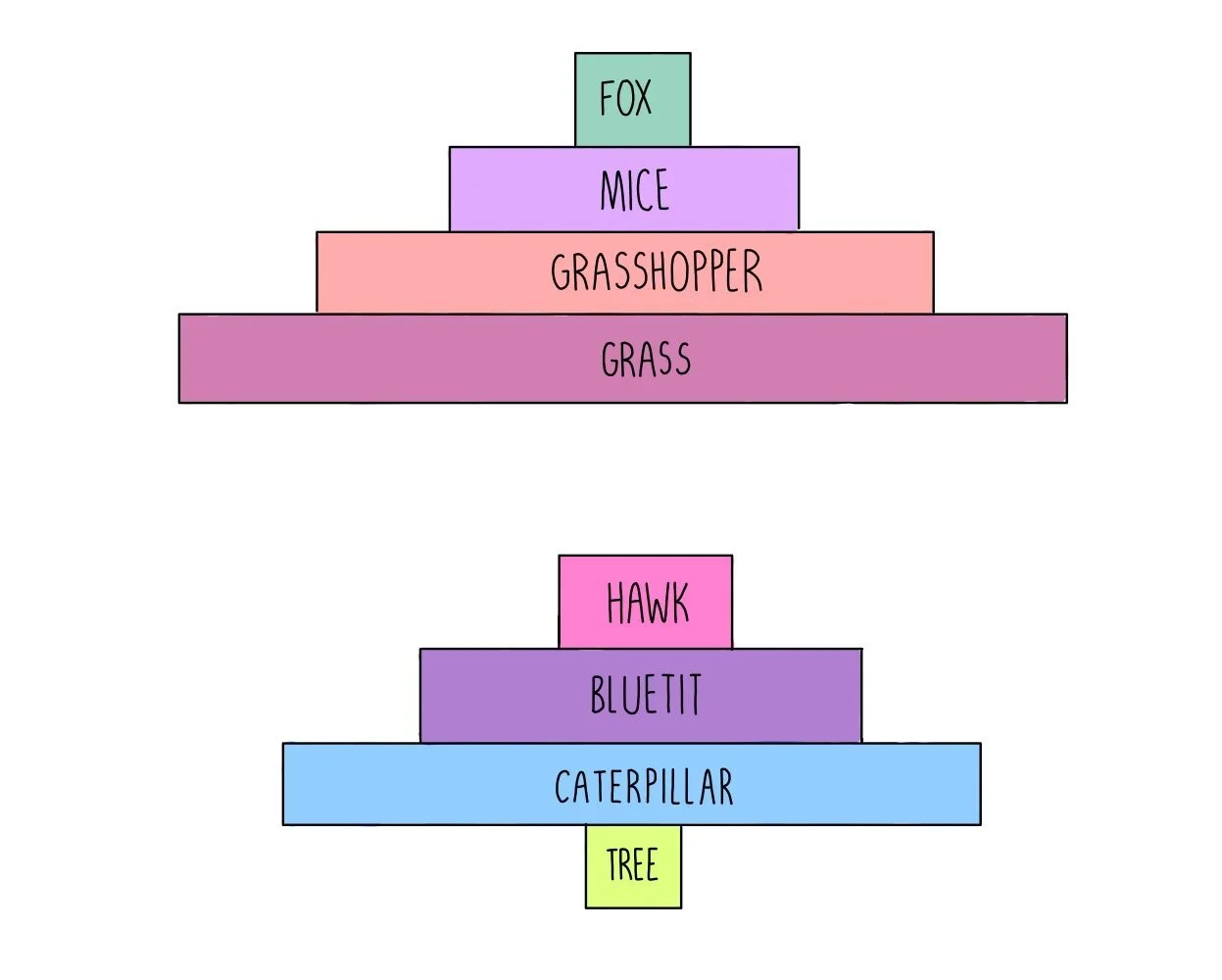Trophic Levels
Organisms eat other organisms to obtain energy for growth. Biomass is transferred when organisms eat each other. Energy, and therefore biomass, is passed along trophic levels of a food chain, from producers to consumers.
Trophic levels
We can use food chains to show which organisms feed on other organisms within an ecosystem and therefore the flow of energy from one organism to another. Energy always starts from the Sun and is converted into glucose by photosynthesis in green plants. Glucose is used in respiration to generate energy which is used to help the organism to grow (increase in biomass). Organisms which produce biomass by capturing the energy from sunlight are called producers and are at the beginning of every food chain. Organisms which feed on producers are called primary consumers and will also be herbivores, since producers tend to be mostly green plants. The next organism in the food chain is the secondary consumer which will be eaten by the tertiary consumer. A predator is an animal which hunts and kills other animals and prey are the animals which are hunted and eaten. Apex predators are carnivores with no predators.
Food chains are always written starting with the producer and followed by the primary, secondary and tertiary consumers. The arrows always point from the organism being eaten to the organism which feeds on it.
Decomposers also play important roles in food chains by breaking down dead matter. When organisms die, decomposers such as bacteria and fungi secrete digestive enzymes onto the dead material. The enzymes break down the molecules in the organism, converting it into simpler substances which can be absorbed by plants, allowing nutrients to be recycled within an ecosystem.
For example, decomposers will feed on fallen leaves, excreted faeces and even whole organisms, such as a dead woodlouse, causing them to decay. The protein, carbohydrate and lipid molecules which make up the organism will be broken down into simple molecules which are small enough to be absorbed by plant roots. In this way, the molecules which used to be part of the woodlouse may be used by the tree to grow more leaves, then the molecules are incorporated into the next organism when those leaves are eaten by a hungry insect.
Food webs
Food webs show the interaction of multiple interconnected food chains in an ecosystem. For example, in the marine ecosystem pictured below there are a number of food chains which are all connected. If the population size of any of these organisms changes, it will affect all the other organisms in the food web. This is known as interdependence.
For instance, if the number of squid in the ocean decreased, this would boost mackerel populations (as there are fewer squid to eat them) and reduce the amount of seaweed and red algae, since there are more mackerel consuming these plants.
Pyramids of numbers
Pyramids of numbers show the number of organisms (the population size) at each trophic level. The producer is represented at the bottom of the pyramid, with the primary, secondary and tertiary consumers represented on the levels above.
Energy is lost at each trophic level of the food chain, which is why the population size usually decreases as you go up the pyramid.
These are not always a pyramid shape - for instance if we have a very larger producer such as a tree, then the number of producers (trees) will be much smaller than the primary consumers which feed on it (such as insects).
Pyramids of biomass
Biomass is the dry mass of a plant or animal species within a food chain. Pyramids of biomass represent the amount of biomass at each tropic level and will have a regular pyramid shape, since biomass is always lost at each step of the food chain. The producer is always found at the bottom of the pyramid. The next species in the pyramid will be the primary consumer, followed by the secondary consumer and finally the tertiary consumer.
Transfer of biomass
Not all of the light energy that reaches producers (plants and algae) is converted into biomass by photosynthesis. This is because some light does not hit photosynthetic parts of the plant (i.e. light rays will hit the tree trunk which cannot photosynthesis). Of the light that does reach the leaves, not all wavelengths of the light will be absorbed. Chlorophyll absorbs light best at wavelengths which correspond to the blue and red parts of the spectrum, reflecting back green wavelengths of light. Producers only transfer about 1% of the incident energy from light for photosynthesis.
Only a small proportion of biomass (around 10%) is passed onto the next trophic level, which reduces the total biomass after only a few stages in the food chain. This is why food chains rarely exceed four or five trophic levels. Biomass is lost at each stage in the following ways:
Used for respiration to generate energy for processes such as active transport and to maintain body temperature
Not all of the organism is eaten (i.e. the bones)
Not all of the organism is digested - some will be excreted as faeces
You can calculate the efficiency of biomass transfers using the equation below:
For example, in a marine ecosystem, krill have a total biomass of 6932 kJ m-2 yr-1. Penguins feed on the krill and have a biomass of 742 kJ m-2 yr-1. To calculate the efficiency of energy transfer, we divide the biomass present in the penguins by the biomass present in the previous trophic level (the krill). (742 / 6932) x 100 = 10.7%

